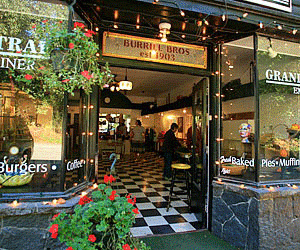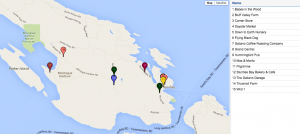Objectives
With only two weeks left until we travel to Galiano Island, we have begun to meet the more critical stages of our planning and strategizing process. Since our main method of creating the index is done through interviewing the island producers, it is necessary that we schedule our meetings prior to our arrival to guarantee that we are able to fit in as many in person interviews as possible. This week we will be calling the local farms and producers to introduce ourselves and to inquire about their availability during the weekend of October 30th. We also plan to contact the restaurants on the island with the hopes of learning whether they utilize any local ingredients, and if so, which products they use during each season. Because our time on the island is short, we decided that it would be best to focus on interviewing the actual producers in person, and communicate with the restaurant owners or buyers from here in Vancouver. Also, given that the buyers for many restaurants are not usually available during regularly scheduled operating hours, communication via email or telephone may be the more effective way to reach them.
Other objectives we have accomplished this week included planning our method of transportation, our overnight stay, as well as outlining timelines for various interviews. We have determined the allotted length for each in-person interview, after factoring in the amount of time left in the day and transportation time in between visits.

Grand Central Emporium and Diner (Taken from: http://www.galianoisland.com/serve/member/163/2012-GrandCentral-GIF.gif)
Significance
When we started our project, we were not certain what our community partner specifically wanted in an index. Miscommunication between our group and the project leader(s) led to some confusion within the group about what was to be drafted for the final product. Some previous planning and ideas became irrelevant, such as questions involving food costs. A clear understanding may have been achieved from the beginning if we had the opportunity to meet the community partner for a greater length of time to ask questions in greater detail. Moreover, some aspects that we originally planned to include in our project, such as the incorporation and promotion of local produce and its nutritional value, may be too ambitious to complete.
These were small hiccups in the long run, and was soon remedied once we directly spoke to two representatives from the community to clarify any misconceptions we might have had regarding their goals with this project. Overall, there was no great loss in of time, however, it was a good reminder to establish the true objectives of the project and to stay focused on these objectives. We also realized that every group member also has to be on the same page, so that the group can work and move forward together.
Once we had a clear direction, delegating tasks followed suit, and we were able to arrange the next steps of the project. These next steps involve contacting producers and businesses on the island in order to document what they grow and when they grow it. In order to streamline this process, two group members will be making all of the telephone calls to arrange interviews. This will prevent possible double-booking or calling. Another step in the next part of our plan is to make a map of all the producers whom we have contact information for. A map will allow us to plot out the groupings of businesses and best routes between them in order to maximize our short time on the island, as we have only two days to conduct what could be 20 or more interviews with locals. This is important as we only have one vehicle so only one interview can be conducted simultaneously. This means that efficiency will be of utmost importance when on the island. By locating where the Galiano producers are located, we can improve efficiency by scheduling with producers that are near each other to avoid wasting time by travelling back and forth.
Podcast 1
In The Fish Bank podcast, there is a theme of conservation of the local environment to benefit the local people. The disappearance of coral and fish from Bali waters was tragic, but the impact of their disappearance on the local people’s’ livelihoods was profound too. This ties into the importance of our community project, our index will encourage the conservation of local producers that will also benefit the local people. This is because local producers live within the same community they serve. Therefore, they have a very personal investment into the wellbeing of the community, in contrast to companies of the imported food found on the island, who only seek to profit. On the other hand, local producers give back to the community in the form of employment, allowing the money to circulate back within the local economy. In contrast, supporting foreign companies will support the employment of workers outside of the local community, thus if Galiano Island does not have any more local producers, employment opportunities within the community would decrease. The result of Jensi and Nyoman’s fish bank was exactly as they had hoped – more and bigger fish. Similarly, we hope that our index, by supporting local producers, will encourage more people to become local producers, and allow existing producers to increase the scale of their production to eventually sustain the entire island’s population.
Podcast 2
In the podcast Grandma Mahembe’s Farm, there is a theme of encouraging young people to pursue a career in agriculture. Lindiwe recalls when her grandmother told her, “I wish that all my grandchildren will grow up to be farmers, and feed not just their families, but all of Zimbabwe.” Her grandmother was an excellent example for Lindiwe, with her 1 acre plot and her livestock that fed not just her 6 children but the community as well. The Galiano Food Program wishes that in the future, more Galiano Island residents will become farmers and help feed the community. After graduating college, Lindiwe spoke about how she would indulge in fast food because it was affordable and right at her doorstep. This reinforces our belief that people are drawn to certain foods because they are easily accessible, and affordable. Our wish is that residents and visitors of Galiano Island will be able to find accessible foods that will encourage nutrition security. Lindiwe defined nutritional security as having access to foods that are nutritious, as well as affordable and convenient. Therefore, we believe that because local produce fulfills this criteria that they are the best way for Galiano Island to also achieve nutritional security.
Podcast 3
In the Pragmatic Idealist podcast, Sisonke Msimang talks about how it is important to listen to not only words, but to silence as well. She demonstrates this lesson in forms of a story she experienced, about her friend Alice. Alice was a strong, confident woman battling HIV AIDS, however this did not limit her from pursuing her goals of being an activist and creating awareness of the fact that it is not something to look down upon. One of the themes that struck out the most was social acceptance within a certain community, and supporting people in your surroundings regardless of the circumstances. This relates to our community project, as the index created will not only support local producers, but will inform the residents of Galiano Island of local food sources. This in turn provides the residents with a greater selection of nutritious and fresh foods that contribute to food security.
Msimang also talks about how her parents suffered a different type of ‘struggle’ in South Africa in the olden times, and how the new generation has it slightly easier with all the improvements in health, education and much more. This provides hope that in the generations to come ahead, the world will place a greater emphasis on acceptance and community building to achieve food security.
